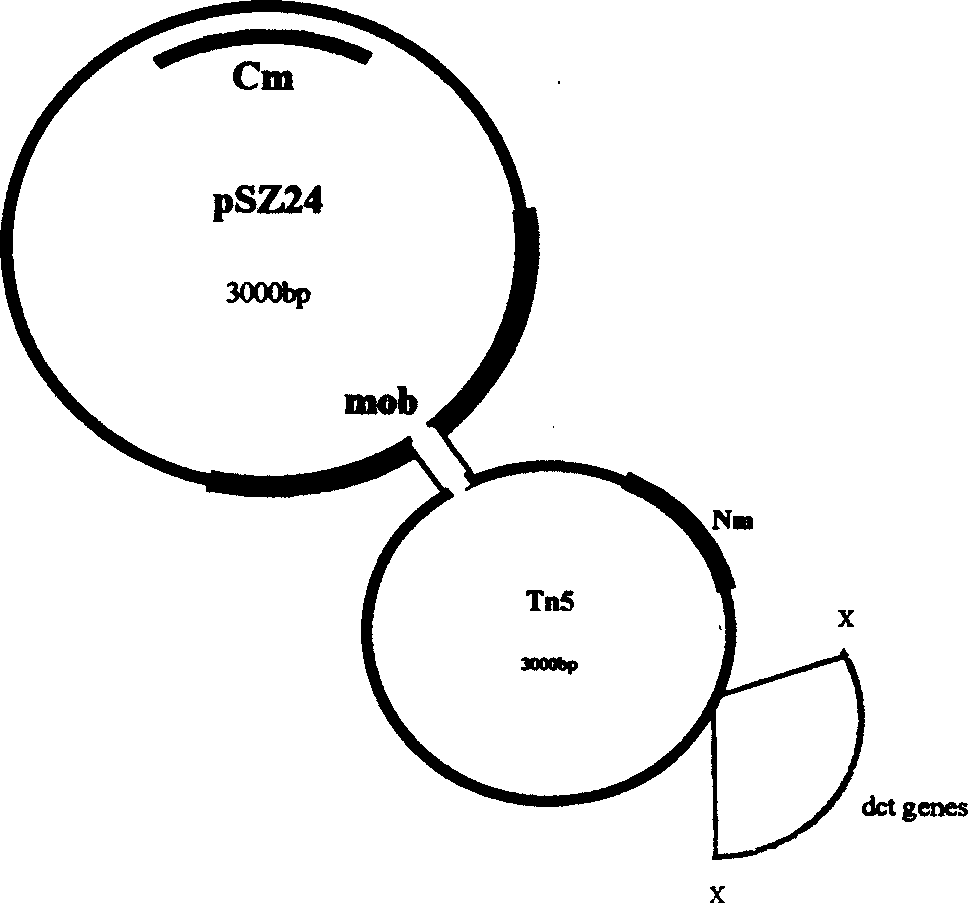Gene capable of improving the nitrogen fixing ability of combined azotobacter and uses thereof
A nitrogen-fixing bacteria, horizontal technology, applied in the application, genetic engineering, plant genetic improvement and other directions, can solve the problems of high energy consumption of biological nitrogen fixation, limited supply of carbon sources, low efficiency of combined nitrogen fixation in the field, etc. effect of function
- Summary
- Abstract
- Description
- Claims
- Application Information
AI Technical Summary
Problems solved by technology
Method used
Image
Examples
Embodiment 1
[0041] The cloning of the DNA fragment that embodiment 1 contains dct transport system
[0042] 1. Collect soil samples rich in nitrogen-fixing bacteria that are non-symbiotic with grasses and isolate total DNA at the community level
[0043] Soil samples were collected from the natural environment of the swamp area where wild barnyardgrass and reeds were grown. Weigh 2 g of the collected soil sample, add 0.6 g of fine glass beads (d<0.11 mm), and shake twice at 4000 rpm. Add 300μl 2% SDS + 12% Tris-buffered phenol (pH8.0) solution on ice for 1 hour, add an equal amount of Tris-buffered phenol, pH8.0 (about 700ml), mix well, and centrifuge at 4°C, 13,000rpm 5 minutes. Add 0.1 volume of 3M NaAc pH 5.2 to the upper layer solution, mix well, add 0.6 volume of isopropanol and mix well. The DNA pellet was dissolved in 200 μl 1×TE (crude DNA). Weigh 100mg of cesium chloride and put it in a new 1.5ml Eppendorf centrifuge tube, add 100μl of crude DNA and mix gently, and let it stand...
Embodiment 2
[0048] Example 2 Identification of plant factor-induced promoters
[0049] The promoter sequence of the dctP gene was amplified by PCR (as shown in SEQ ID NO: 7), and Xho I digestion was inserted into the vector pVK100 (Tc resistance, Km resistance) and then inserted into the lacZ gene to screen for The only Tc-resistant transformant. Through the conjugation experiment, it was transferred into Pseudomonas stutzeri A15, and the recombinant bacteria were screened for Tc resistance. The recombinant bacteria expressed 1acZ in the medium added with fumaric acid, malic acid, succinic acid and other four-carbon dicarboxylic acids, and the colonies showed blue spots, indicating that the promoter was a plant factor-induced expression promoter.
Embodiment 3
[0050] Embodiment 3 Construction of combined nitrogen-fixing engineering bacteria
[0051] The XhoI fragment containing the dctPQM gene cluster was ligated into the shuttle vector pSZ21 to construct the recombinant plasmid pSZ24, transformed into E. Coli DH5α, and then transferred into Pseudomonasstutzeri A15 with the help of the helper plasmid pRK2013 through triparental conjugation. The recombinant bacteria that integrated the dct gene cluster into the chromosome of Pseudomonas stutzeri A15 were screened. Plasmid constructs such as figure 2 shown.
[0052] In the saline-alkali soil test field of Panjin City, Liaoning Province, the engineered bacteria were respectively carried out in the plot experiment of field release. The plot area was 10 square meters, and there were three repetitions. Wild bacteria and aseptic controls were set. The treatment method is to use the overnight culture solution to dilute 100 times to dip the rice roots. The test results show that the recom...
PUM
 Login to View More
Login to View More Abstract
Description
Claims
Application Information
 Login to View More
Login to View More - R&D
- Intellectual Property
- Life Sciences
- Materials
- Tech Scout
- Unparalleled Data Quality
- Higher Quality Content
- 60% Fewer Hallucinations
Browse by: Latest US Patents, China's latest patents, Technical Efficacy Thesaurus, Application Domain, Technology Topic, Popular Technical Reports.
© 2025 PatSnap. All rights reserved.Legal|Privacy policy|Modern Slavery Act Transparency Statement|Sitemap|About US| Contact US: help@patsnap.com


